Suarez & Josek Use Insects & Robots to Teach Bioinspiration at STEAM Studio

Illinois Entomologist Andy Suarez demonstrates for some students how certain insects' legs work.
October 14, 2015
Taking a short break from their entomology research, Illinois Professor Andy Suarez and Ph.D. student Tanya Josek visited Next Generation School’s STEAM Studio, an after-school program that incorporates art into its STEM activities (Science, Technology, Engineering, ART, and Math). There they taught the students about bioinspiration— how biology can inspire engineering. The two incorporated a variety of hands-on activities guaranteed to engage the youngsters, teaching them about a couple of their favorite subjects: insects and insect-inspired robots.
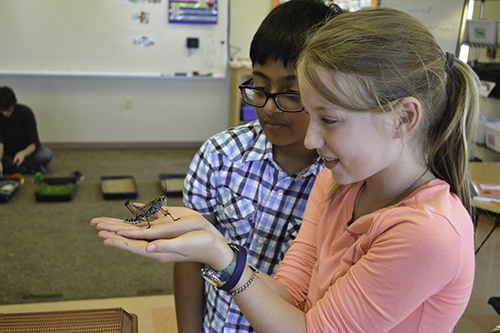
Two STEAM Studio participants examine a very large grasshopper up close.
Highlighting the research of Dr. Suarez and Dr. Marianne Alleyne (who was unable to attend the outreach), Suarez and Josek were delighted to share a bit of what they know about insects. However, they didn’t just show a Powerpoint with pictures of insects; they brought along several crates with some live insect friends the kids could study then draw. A few of the more intrepid students even got to hold them. Plus, as part of the lesson, which included the scientific method, the students tried out a raft of robots which mimic the way different insects move. (And yes, the kids even got to hold the remote.)
According to Coordinator Angela Nelson, the STEAM program invites guest experts and goes on field experiences in order to provide students opportunities to work with and talk to experts in the field. "One of the missions of STEAM Studio is to provide relevant and authentic, real-world connections to the concepts we cover in our program," says Nelson, then adds that Suarez and Alleyne’s research on insects was a perfect fit to their unit on biomimicry.
"They were able to involve the students in a real lab experiment that explored the mechanics of the insect leg highlighting engineering implications for robotics. Allowing the students to observe the insect’s locomotion and then explore mirrored robotic motion was a fantastic way for the students to recognize the depth of our topic and the importance of biomimicry in their own lives."

A STEAM Studio participant prepares to test a robot on a variety of terrains.
Suarez and Josek wanted to visit the Champaign school’s program because both see outreach as important and a fun way to educate the public. Plus, they felt their area of research epitomizes STEAM:
“Our lesson was about bioinspiration," explains Josek, "which I feel fits into all of the subjects STEAM embodies (Science, Technology, Engineering, Art, and Mathematics)." She then goes on to explain how what they do dovetails nicely with each STEAM discipline:
“When we use insects as the basis for a robot we design, there are a lot of aspects to consider, so we really need to know the science or biology behind the insect first. Why do insects move the way they do, and what allows them to do this? Designing this robot takes both mathematics and an art skill to create, while actually building your design takes technology and engineering skills.”
According to Josek, bioinspiration can help students see a connection between two seemingly disparate areas: “Biology and engineering don't have to be separate subjects, because they can really complement each other in many ways.”
Of course, as scientists, Suarez and Josek felt obliged to encourage the students in the use of the scientific method. After watching the insects move and studying their different adaptations which allow them to move through a variety of terrains, students were encouraged to develop hypotheses regarding which robot designs would be able to navigate best through a variety of terrains: screen, grass, larger rocks, small pebbles, and sand. Then the students “test drove” the robots through the different terrains to see if their hypotheses were correct.
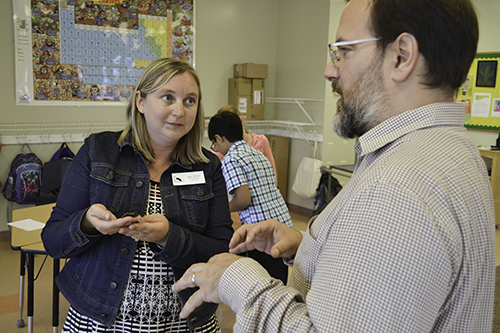
Suarez (right) explains to the STEAM Studio coordinator, Angela Nelson, about the isect she's holding.
According to Josek: “The students were able to practice the scientific method, create hypotheses based on the insects they saw and what results they expected. They also reflected on their hypotheses and the reasons why they saw a specific outcome.”
Since the students were divided into teams, Josek indicates that they also learned another valuable skill: “An extra benefit was they were able to practice teamwork and discuss results,” she acknowledges, “which is extremely important skill in any field.”
Nelson enumerates additional benefits to her students: " First of all, they had the opportunity to observe and discuss the behavior and anatomy of a wide range of insects with an expert. One of my students is still talking about the lubber grasshopper weeks after the visit. It was wonderful for students to see another use for technology that went past their everyday concepts of i-pads and computers. They were in awe with how a Hexbug could be adapted to mimic the legs of insects. Another important component was the real-world application of why they were conducting the experiment and how it could impact the field of motorized robotics. Finally, giving the students the opportunity to work and research beside scientists makes it meaningful for them to make careful observational drawings, be accurate when collecting data, and helps them recognize that troubleshooting is a part of the job."
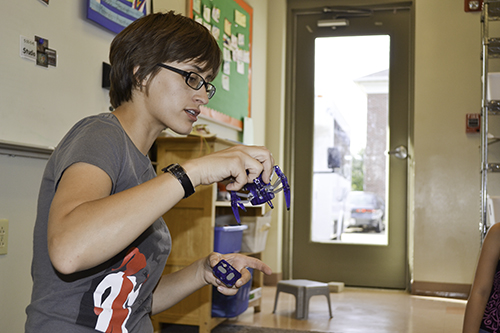
Ph.D. student Tanya Josek describes the robot she's holding and has the students suggest which type of terrain it might be able to navigate.
Suarez participated in the outreach at STEAM Studio because it is not only is important to help educate he public, but that researchers benefit from outreach as well.
“I think outreach is essential for improving scientific knowledge, educating the public to what we do and why we do it…and it is really fun,” he admits. “Outreach can also increase the visibility of work in ways that we benefit from as well; it is really a two-way street.
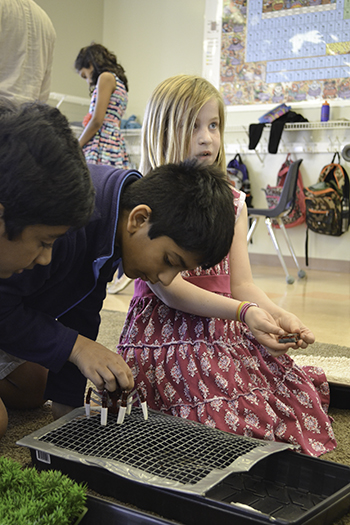
Several students prepare to test a robot on screen.
While Josek also believes outreach is valuable to help educate the public, she is also cognizant that insects tend to get a bad rap. Part of her motivation behind participating in outreach is to rectify that:
“I love to do outreach because it's fun and is a great way to interact with the public and share what you love, in this case, insects, with them. People interact with insects on a daily basis, and as an entomologist, I feel that we should be available to the community around us to help them learn about these insects and spiders they see and clear up any misconceptions about them as well.”
Plus, since children often tend to be afraid of insects, she hopes to help youngsters overcome their phobias.
“The STEAM Studio outreach event is a fantastic opportunity to teach kids about insects,” says Josek, “especially because in many cases, a fear of insects starts at a younger age, so interaction with insects can really help.”
Suarez reports that the event went well: “The kids enjoyed learning about insects, the way they walk, and how we may design robots for different terrains based on what we learn from studying insect locomotion. The kids liked seeing the different insects, drawing them, and also controlling the robots (that was probably their favorite part).”

A student at STEAM Studio examines a very large grasshopper.
“I believe the event went very well," Josek agrees. "The students could see a clear connection between the robot design and insects as well as the relationship between insects and the modifications we added to the robots to help them cross the various terrains.”
Did the two see any future scientists or engineers? "Definitely," Suarez reports. "Early exposure to science like this reminds kids that anyone and everyone is a scientist, and it is not a geeky or odd career choice.”
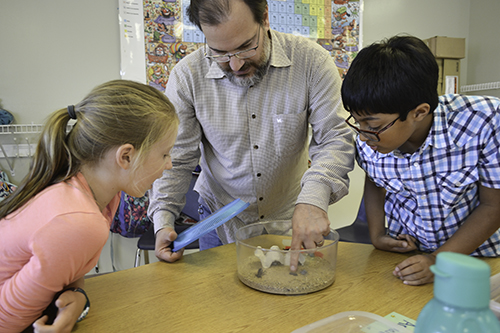
Suarez (center) discusses some of his insects with a couple of STEAM Studio participants.
Josek agrees. “Most definitely,” she says. “There were certainly some students that showed a larger interest in science and engineering than others, but I felt that all of the students at least showed a glimmer of an interest in science and engineering.”
STEAM Coordinator Nelson agrees, enumerating the benefits experiences like Suarez & Josek's visit provide her students: "Students grow so much from these experiences; they learn how to ask questions about scientific fields that they are curious about; they learn different ways to solve real-world problems that they may not have thought about before; they discover how exciting the STEM fields can be, and it opens their eyes to the reality that the fields of STEAM are diverse and very exciting to be a part of."
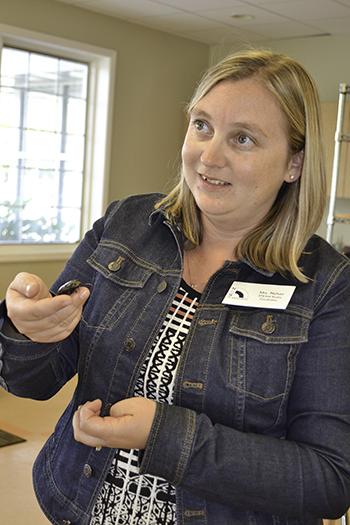
STEAM Studio Coordinator Angela Nelson.
And the activity appears to have had a lasting impact on the students. According to Nelson: "The kids always leave from these guest experts ready to take on the world. They really enjoyed conducting the terrain experiment with the Hexbugs and spent the next day discussing other terrains and leg designs they would like to try. Some students had a more lasting impression of the insects and have been seen observing the insects at our park and sharing what they learned with the younger students".
A very important impact that it had is that students saw how they too can do meaningful science and that the field of opportunities in their STEM eyes has just grown a little bit larger."
Nelson, who is "always looking for experts and field experiences to make this program the best that it can be," invites experts to present at STEAM studio. "These collaborations can be as small as a SKYPE interview or as large as a long-term citizen science project," she elaborates. "If anyone has interest in offering their expertise or being a part of the program, please contact us. I feel so fortunate to be coordinating such a dynamic program that has taken students all over the Champaign-Urbana community from explorations of the jets at the airport, helping to roll out hay at the sustainable farm, to investigating insect biomimicry. Every student has made a connection and learned something new from these generous people who offer their time and resources to impact the next generation of thinkers."
Story and photos by Elizabeth Innes, Communications Specialist, I-STEM Education Initiative.
More: K-6 Outreach
, Faculty Feature, Next Generation School, STEAM Studio, Student Spotlight, 2015
Additional I-STEM articles about STEAM Studio:
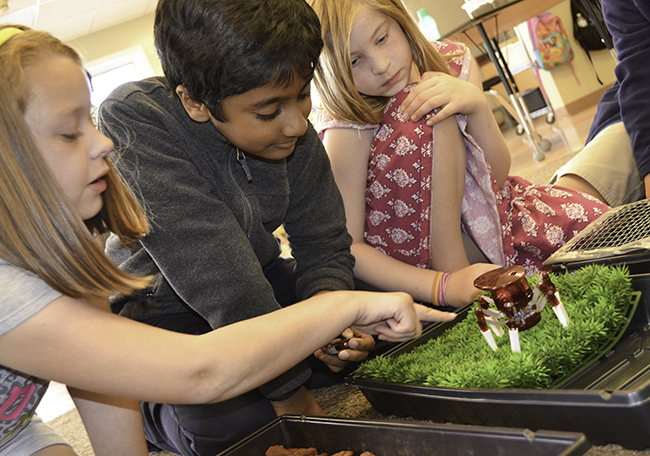
One team of students tests a robot out on grassy terrain.













.jpg)
















